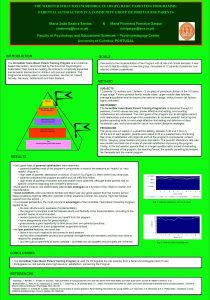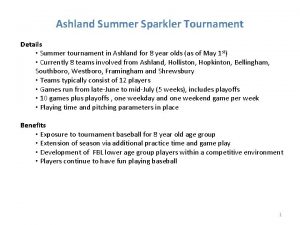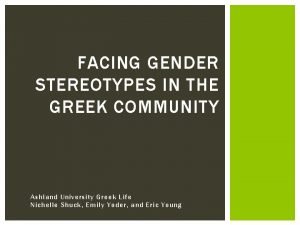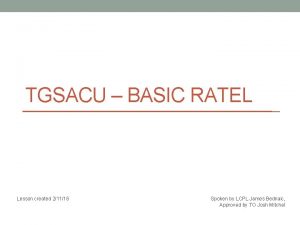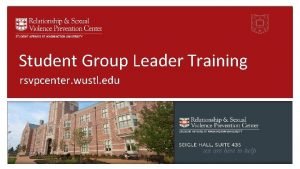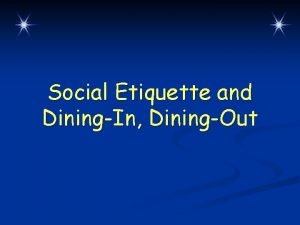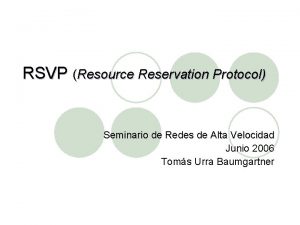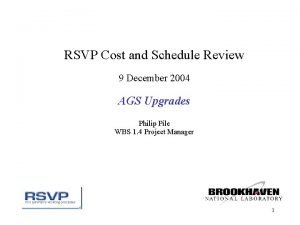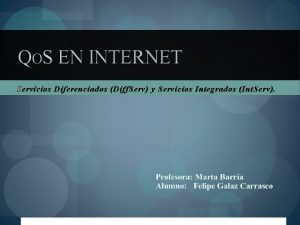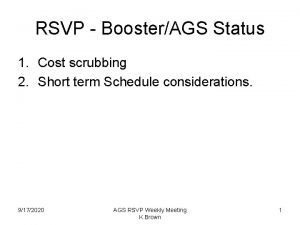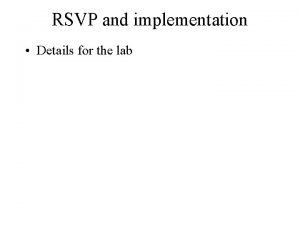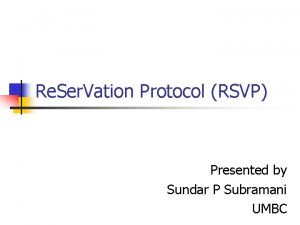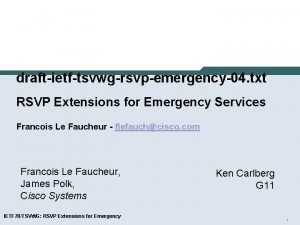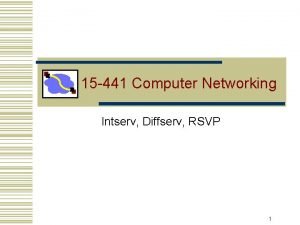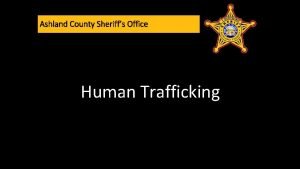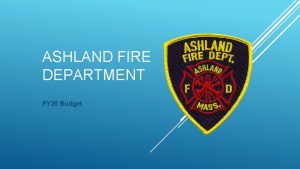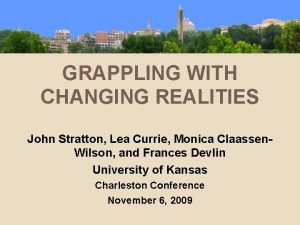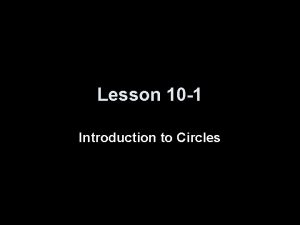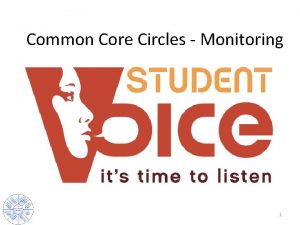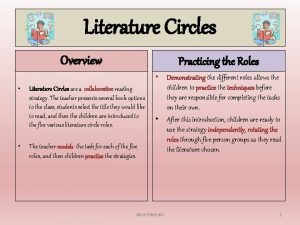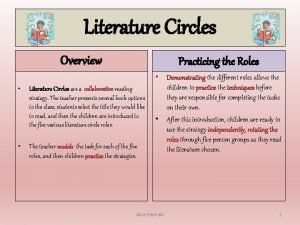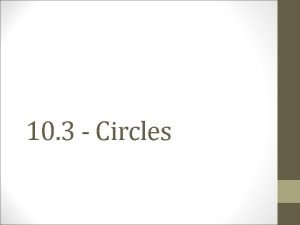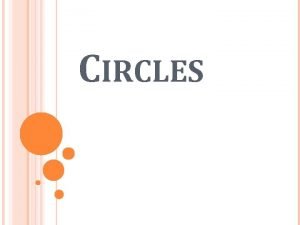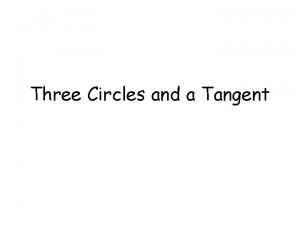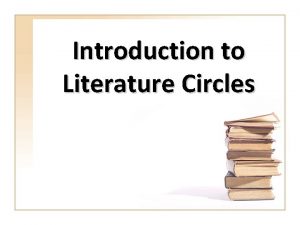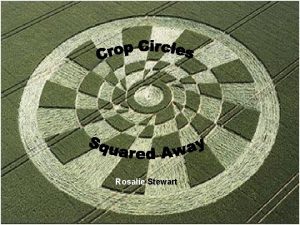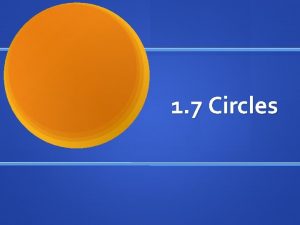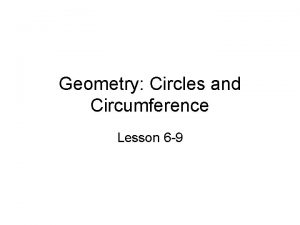RSVP Conference Working with Circles John Stratton Ashland
























- Slides: 24

RSVP Conference! Working with Circles John Stratton Ashland Center for Nonviolence Cindy Swanger Lifeworx Yvonne Gramse Lifeworx

Welcome to T. A. L. K.

Community Partnership With additional support from Park Street Brethren Church Wooster Friends Meeting & Others throughout the community

Working with Circles • • • Origins of the circle process Role of circles as a conflict resolution tool Basic circle process & the way that circles work The Lifeworx story, Testimony from the Trenches Pitfalls and challenges in using circles Possibilities for using circles – build community values – serve as a support group – discover and resolve potential problems in the group

Conflict – it’s always with us With children With parents With siblings With wives, husbands, significant others • With neighbors • With co-workers • • About things About duties About money About what was done & not done • About what was said and not said • About rumors, back biting, & gossip • •

Conflict – it changes things Destructive Conflicts Constructive Conflicts • People interact with intent to protect self & hurt the other • People are rigid, inflexible, insistent • People become stuck in & defined by the conflict • Increased fear, anger, • “Fight or Flight” • Focus on self-interest • Competitive & destructive • People interact with intent to learn rather than to protect • People change, adjust, compromise • People allow conflicts to move & change • Increased self-esteem, motivation for positive connection • Focus on relationships • Primarily cooperative

Conflict Resolution “Typical” Responses – Competitive • Yelling, Screaming, Silent Treatment • Hair pulling, Face Scratching, Slapping • Fighting, Shooting, and More Nonviolent Responses – Cooperative • • • Coin Tossing Rock, Paper, Scissors Tug-of-War – Community Activity MEDIATION CIRCLE PROCESS

Two Types of voluntary Conflict Resolution • Community Mediation • Circle Process

Restorative Values • • • Healing rather than Hurting Moral Learning Community Participation and Community Caring Respectful Dialogue (Forgiveness, Responsibility) (Apology and Making Amends)

Things that look like mediation • Arbitration – contract-required, fact-finding & decision making • “Mediating” – getting in the middle • Mediation – court-ordered, e. g. divorce & related matters, voluntary solution • Mediation – voluntary searching for win-win agreement

Community Mediation • Adversarial Disputes (mediation may be mandated by courts or other agency) • Fact Based (but not evidence based) • Formal Process & Structure • Disputants Create Solutions that Everyone Can Live With • Focus on Problem Solving • BTW – No cost

What belongs in Mediation What Can Be Mediated What Cannot Be Mediated Behaviors • How people treat each other • Sharing space • Respecting boundaries Things • Property • Reimbursement • Loans Structures & Systems • Procedures • How decisions are made • • • Beliefs Principles Truth of something Addictive behavior Feelings Abusive situation or behaviors • Issues of people who are not present

Circle Process • Community Focus (but may be framed by courts, school, or other agency) • Often Story/Experience Based • Always Values Based • Formal Process & Structure (but may include other structures, such as brainstorming or small group work) • Community Identifies Problems, • Community Creates Solutions • Focus on Building Trust, Understanding, and Community

Modern Origins of circles • Restorative Justice Movement Howard Zehr, Eastern Mennonite Univ • Indigenous People, Pacific Rim (Maori People) New Zealand Juvenile Justice System • Minnesota Department of Education, among others

Components of Circle • Opening and Closing Moments Creating a Sacred Space – Calm, an Oasis Set Off from the World • Talking Piece Ensuring Equal Contribution at a Reflective Pace • Center Piece Allowing for a Visual Time Out • Circle Agreements To Speak and Listen from the Heart • Time to Create Community Before “Attacking” Problems

Typical Agreements during a circle • Speak & Listen from the Heart • Respect the Talking Piece • Take the Time You Need, But Remember that Others Need Time • You May Pass • What Is Said in Circle, Stays in Circle

Using Circles When to Use Circles • Check In & Check Out • Community Building • Welcome or Farewell • Celebration or Loss • Problem Solving • Stressful Moments (before they get disruptive) • Stressful Moments (after they have calmed down, but not pointing at people) When Not to Use Circles • Possibility of Continuing Pain • Possibility of Retribution • Power Imbalances When to Use Circles Cautiously • Repairing the Harm • Bringing Victims and Offenders together

Why circles work • Happens in a Different Place • Happens at a Different Pace Introduction, Agreements, Shared Values Before “Work” • Starts with and Focuses on Strengths • Exchanges Ideas in Oblique Ways Storytelling Embodies Values Storytelling “Prevents” Preaching • People Reflect on Experience • People Come to Their Own Quiet Discoveries

Lifeworx • A consumer operated program challenging and encouraging persons who find life difficult. • A place that provides belonging, friendship, trust, caring and security in an atmosphere that helps support recovery from mental health issues and addictions.

Lifeworx -Tales from the Trenches • Cindy Swanger Lifeworx • Yvonne Gramse Lifeworx

Questions – Comments & Then We Eat


For More Information on Circles or Circle Training Contact Ashland Center for Nonviolence John Stratton, 419 -289 -5313 jstrat@ashland. edu

For Information on Mediation and Mediation Training 419 -207 -TALK (8255)
 Math portfolio project
Math portfolio project Caroline webster stratton
Caroline webster stratton Webster stratton incredible years
Webster stratton incredible years Ashland sparkler
Ashland sparkler Ashland natrosol
Ashland natrosol Ashland university greek life
Ashland university greek life Ashland botox
Ashland botox Ashland county wi gis
Ashland county wi gis Ratel speed test
Ratel speed test Rsvp center washu
Rsvp center washu What is the first rule in social correspondence
What is the first rule in social correspondence Rsvp protocol
Rsvp protocol Rsvp meaning
Rsvp meaning Rsvp cost
Rsvp cost Servicios integrados ejemplo
Servicios integrados ejemplo Rsvp movies sql assignment
Rsvp movies sql assignment Rsvp
Rsvp Rsvp
Rsvp Rsvp
Rsvp Rsvp
Rsvp Rsvp 1
Rsvp 1 Smart vs hard working
Smart vs hard working Cold working and hot working
Cold working and hot working Hot working and cold working difference
Hot working and cold working difference Machining operations
Machining operations


